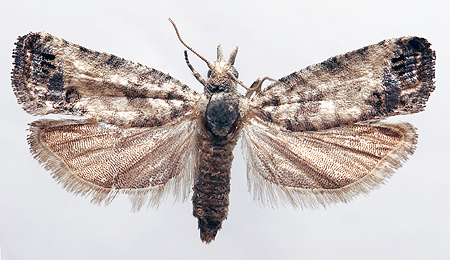Pests
Spilonota albicana Motschulsky - White Fruit Moth, Larger Apple Fruit Moth, Eye Spotted Bud Moth.
Systematic position.
Class Insecta, order Lepidoptera, family Tortricidae, subfamily Olethreutinae, tribe Eucosmini, genus Spilonota.Synonym.
Tmetocera prognathana auct.Biological group.
Polyphagous pest of rosaceous fruiters and forest species.Morphology and biology.
Forewings albesent, with grayish cross waviness at base and along anterior margin, darkened at apex (wingspan 13-15 mm). 3-4 blackish longitudinal strokes or points located one after another just before outer margin, edge with cross lead-shining lines. Hindwings gray. Males with emarginated basal segment of antenna. Egg transparent, flat. Caterpillar light, with rather large brown spots along whole body having dirty-gray overall coloring, 15-18 mm in length. Pupa yellowish-brown. Adult caterpillars winter in white cocoons in bark crevices at radical trunk parts, in leaf litter or in surface layer of ground. In spring, they pupate in the same places. Caterpillars of spring generation develop 25-30 days. They eat leaves, buds, flowers, and ovaries; pupating mainly in plaited leaves. Pupal stage lasts about 20 days. Summer generation is more harmful; moths lay eggs on fruits mainly, caterpillars eat generative organs mainly and reduce yield directly. Hatched caterpillars penetrate into fruits at calix, less often at base of fruit pedicle or sideways, and gnaw out chambers. A spot or swelling is formed on fruit surface because of congestion of frass. On small-fruited rosaceous plants, they plait several fruits with silk threads, changing the fruits while feeding. Caterpillars of older ages are located inside fruits, eating them at calix. Having finished their feeding, the caterpillars leave a tree crone, going in places of wintering.Distribution.
The species occurs in Korea, Japan (Hokkaido, Honshu), Northeast China. In the former USSR, it is distributed in Transbaikalia, the Far East (Amur Region, Khabarovsk and Primorskii Territories). It has been recorded as imported on bonsai trees (Malus) from Japan into the Netherlands.Ecology.
The species has 2 generations southward of the river Amur. In spring, caterpillars pupate in April or May. Moth flight lasts since mid-May till June (1st generation) and since mid-July till the end of August (2nd generation), but having vague phenological borders between the generations. Caterpillars of 1st generation appear at the end of May. The caterpillars of 2nd generation finish development and abandon fruits since the end of August.Economic significance.
This is a dangerous pest of foliage, buds and fruits of cultural rosaceous fruiters in the south of the Far East. In some areas of Primorskii Territory, it destroyed to 77-85% of yield of large-fruited apple varieties. In addition to cultural apple, pear, cherry, and plum trees, the caterpillars damage wild rosaceous trees in parks and forests, such as Pyrus ussuriensis, Malus pallasiana, M. manshurica, Sorbus amurensis, Crataegus dahurica, C. maximowiczii, Cotoneaster raelanocarpa, Cerasus tomentosa, Prunus sp. Control measures. Agronomical measures include removing of old bark from trunks and branches, removing of vegetation residues, scalding of props and containers, digging of ground to kill wintering caterpillars, use of trapping bands on trunks in middle and on large branches at their base; survey of trapping bands and destruction of caterpillars every 10 days; collection of fruit drop with its subsequent removal from a garden. Chemical measures are insecticide treatments during early leaf development against caterpillars of 1st generation; the other ones against caterpillars of 2nd generation, combining them with treatments against peach fruit moth Carposina niponensis Wlsgh. and Manchurian fruit moth Cydia inopinata (Heinrich). Shtundyuk & Ablakatova (1969) have recommended to carry out 1-2 chemical treatments in the zone of development of one generation and 2 treatments against each generation in the zone of development of 2 generations of the pest.Reference citations:
Ermolaev, V.P. 1988. Tortricidae. In: Kirpichnikova, V.A., Ler, P.A., eds. Butterflies - pests of agriculture in the Far East. Keys. Vladivostok: Biology and Soil Institute, DO AN SSSR: 65-99 (in Russian).Kuznetsov, V.I. 1976. Leafrollers of the tribe Eucosmini (Lepidoptera, Tortricidae ) of the South of the Far East. In: Skarlato, O.A., ed. Herbivorous insects of the Far East. Trudy ZIN, vol. 42. Leningrad: ZIN, p. 70-109 (in Russian).
Kuznetsov, V.I. 1994. Family Tortricidae. In: Kuznetsov, V.I., ed. Insects and mites - pests of agricultural plants. V. 3(1). Lepidoptera. St.Petersburg: Nauka, p. 51-234 (in Russian).
Kuznetsov, V.I. 2001. Family Tortricidae (Olethreutidae). In: Ler, P.A., ed. Keys to the insects if the Russian Far East. V. 5(3). Trichoptera and Lepidoptera. Vladivostok: Dal.nauka, p. 11-472 (in Russian).
Shtundyuk, A.V., Ablakanova, A.A. 1969. Pests and diseases of fruit-berry cultures and vines in the Far East and their control. Khabarovsk: Khabarovsk Publishing House, 140 p. (in Russian).


